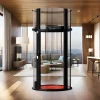Safe Elevators Than You Thought?
How often do you step into a safe elevator in a day? Whether living or working several stories above the ground, people rarely think about the electromechanical systems that smoothly lift and lower them. Let’s delve into the safety mechanisms that make elevators safer than you might imagine.
Elevator Cables Provide Stability
The primary element ensuring a Safe Elevators sturdiness is the steel cables supporting it. Typically, there are six to eight cables in each cabin. Even if all but one cable fails, the elevator remains secure, as each steel cable can hold more than the cabin’s weight.
Building codes mandate a factor of safety of 12, meaning the combined strength of the cables must support 12 times the mass of a fully loaded cabin. In essence, each cable can bear more than the cabin’s weight.
In a historical incident in 1945, a B-25 bomber crashed into the Empire State Building, severing all elevator cables. Surprisingly, the lone passenger survived the fall from the 79th floor, thanks to the deceleration and cushioning provided by the cables. Similarly, the elevators at the World Trade Center, cut during the September 11, 2001 attacks, led to unfortunate casualties.
Elevators are equipped with two to three types of brakes. If a safety chain error occurs, a clamp engages on the pulley above the cabin, preventing movement. Unlike a vehicle brake, which requires depression to engage, the elevator brake remains clamped unless power is supplied, ensuring safety during power loss.
A safety brake is also attached beneath the elevator, a modernization unveiled at the 1853-54 World’s Fair in New York, making passenger elevators possible.
How does the safety brake work? If sensors detect the cabin speeding downward, it activates a metal brake beneath the cabin into a channel in the guide rails, slowing the car at a comfortable rate.
An additional fail-safe exists. On the cable ends attaching to the elevator cabin, counterweights are present. These weights, slightly heavier than an empty car and slightly lighter than a fully loaded one, serve as a last resort. In case of a complete safety system failure and an empty car, these counterweights make the elevator ascend instead of descend, gradually accelerating. A fully loaded cabin, in contrast, experiences a slow de-accelerating descent.
While these scenarios are distant possibilities, remember that statistically, elevators are still safer than taking the stairs!”








